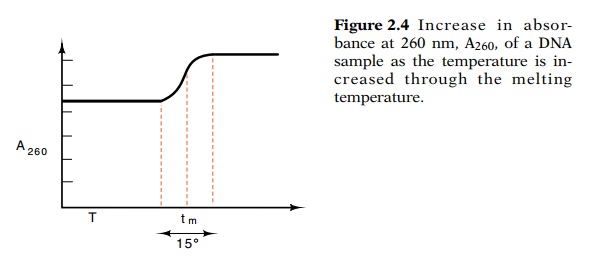Chapter: Genetics and Molecular Biology: Nucleic Acid and Chromosome Structure
Dissociation and Reassociation of Base-paired Strands
Dissociation and Reassociation of Base-paired
Strands
Heating DNA in solution breaks the hydrogen bonds
between the A-T and G-C base pairs, unstacks the bases, and destroys the
double-helical structure of the DNA. Such a process is called melting.
Generally, not all the bonds break at one temperature, and DNA exhibits a
transition zone between fully double-stranded DNA and fully melted DNA that
often is 15° wide. The midpoint of this melting zone is defined as the melting
temperature, which occurs at about 95° in 0.1 M NaCl. The actual value of the
melting temperature, however, depends on the base composition of the DNA, for
the three hydrogen bonds in G-C base pairs provide more stability than the two
found in A-T base pairs. The ionic composition of the solution also affects the
melting temperature. The higher the concentration of an ion such as sodium, the
greater the shielding between the negatively charged phosphates and the higher
the melting temperature. A divalent ion such as magnesium is still more
effective in raising the melting temperature of DNA.

Melting can be observed in a variety of ways. One
of the simplest is based on the fact that unstacked bases have a higher
absorbance in the ultraviolet region of the spectrum than stacked, paired bases
(Fig. 2.4). Therefore the absorbance of DNA in the ultraviolet region increases
as the DNA melts, and by following the optical density of a DNA solution as a
function of temperature, a melting curve can be obtained.
A most remarkable property of denatured DNA is its
ability to renature in vitro to
re-form double-stranded DNA. This re-formation of double-stranded DNA usually
is very precise and exactly in register. Two strands may renature to the native
double-helical form if their sequences are complementary, that is, if their
sequences permit extensive formation of hydrogen-bonded base pairs.

The ability of self-complementary sequences to
hybridize together and form a double helix is not unique to DNA; RNA can also
do this, and it is possible in vitro
to form RNA-DNA hybrids or RNA-RNA duplexes. The ability of nucleic acids to
renature has been extremely important in the development of molecular biology
as it has provided ways of detecting the presence of small quantities of
specific sequences of RNA or DNA and in some cases to determine their
intracellular locations through their ability to form sequence-specific
duplexes.
Related Topics